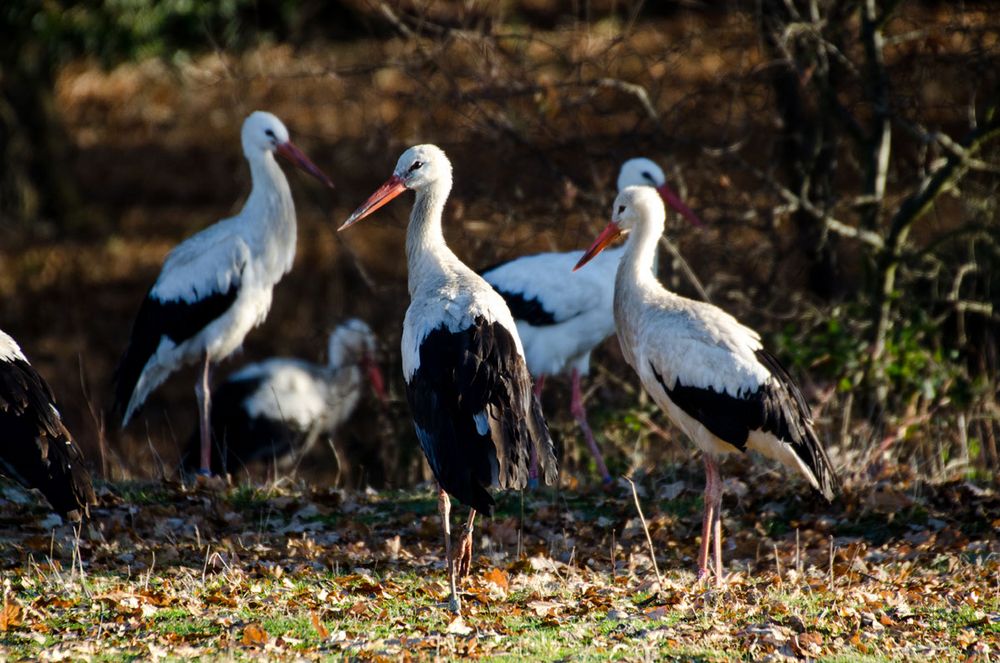Knepp Wildland and Storrington, United Kingdom, 2025
Facts and Figures
- Location:
- England, West Sussex
- Population:
-
 20Min. and max. numbers of breeding pairs since the year 2000
20Min. and max. numbers of breeding pairs since the year 2000 10.000Inhabitants in the year 2017
10.000Inhabitants in the year 2017 - White stork in in English:
- White Stork
- Nesting sites:
- Nearly all are nesting in mature Oak trees.
- Events:
- In 2025 we are putting on the first of what we plan will be an annual event of celebration – a White Stork and Nature Revival Festival in Storrington. Prior to this we have had an annual White Stork Project celebration which coincided with the release of captive bred birds.
Contact
Knepp Estate owners – Isabella Tree and Charlie Burrell
White Stork Project Manager – Laura Vaughan-Hirsch (laura(at)knepwildlandfoundation.org)
Landscape and habitat
Knepp Estate is a 3,500 acre rewilding project which began rewilding just twenty years ago. Since then, endangered species such as nightingales, turtle doves and purple emperor butterflies have found sanctuary there. Herds of old English longhorn cattle, Tamworth pigs, Exmoor ponies and red and fallow deer wander the landscape, their disturbance shaping the water meadows, shrubland and wood pasture, creating new habitats for wildlife. White storks thrive in this environment and last year 53 chicks fledged from the wild at Knepp.
Storrington is nearby to Pulborough Brooks, a RSPB nature reserve in the Arun Valley, offering diverse habitats and seasonal wildlife spectacles. In spring, warblers and Nightingales fill the air with song, while Lapwings perform aerial displays over the wetlands. Summer brings dragonflies and damselflies in abundance, with night-time sightings of Nightjars, bats, and Glow-worms. Autumn reveals colorful fungi across golden woodlands, and in winter, visitors can witness vast flocks of wildfowl and hunting Peregrines.
The storks mainly use the rewilding project at Knepp Estate to forage, on what was previously farmed land. They favour areas near to steams or ponds that are grazed by herbivores including English Longhorn cattle, Tamworth pigs and Exmoor ponies as well as Red and Fallow deer.
Current activities and vision for the future development

Nearly 2000 young people come to visit the White Stork Project at Knepp each year, they are taken on ‘safaris’ and spoken to by the ecologists about nature using storks as a focus. Some of them are invited to watch the scientists ring the chicks and talk about the science involved in the data collection, some local schools have named stork chicks and followed their progress.
Knepp Estate has a free set of resources for schools on theier website, designed to complement the National Curriculum but using storks as a case study to investigate habitat types, migration and animal behaviour.
People are generally positive about the storks and travel to see them. There is a lot of fantastic nature conservation work going on in Sussex and the employees of Knepp Estate are proud to be able to highlight this as part of the White Stork and Nature Revival Festival, which is planned to be an annual event.
The stork village plans to continue using the white stork as an emblem for nature recovery and hopes to inspire people to connect with nature more. They’ll continue to develop their education/ outreach programme to engage with young people which is a very important part of the project. Research is another highly important aspect and they have exciting plans for future research opportunities to help them learn as much as they possibly can about UK storks. The ambitions of the stork conservationists in Storrington expand beyond the borders of the country and they hope to connect with communities all along migratory pathways, ideally working to preserve habitat for storks and other species.
From ‘Storketon’ to 'Storrington'
Back in the 12th century the town of Storrington in West Sussex, just seven miles from Knepp, was known as ‘Storketon’, or ‘Storcatun’ in old English, meaning ‘homestead with storks’. To this day, the emblem of a pair of storks is featured on the town sign. Traditional pasture and wetlands in the surrounding countryside would have provided storks in Storrington with the perfect feeding environment.
Local players
Storrington and Sullington Parish Council, Cotswold Wildlife Park, Roy Dennis Wildlife Foundation, University of East Anglia, University of Brighton, Knepp Wildland Foundation. Several local schools regularly visit the project.
 Report sighting
Report sighting
Have you seen a white stork or another interesting species of animal, plant or fungus? Make your observation count for nature conservation and share it with other nature lovers! It’s free and it’s fun!






